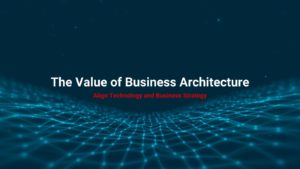The traditional hierarchical organizational structure in which most of us continue to work is a remnant of the early industrial age. This management approach was developed in the early twentieth century to address business efficiency and profitability in business cycles measured in years. Typical working environments in enterprises of the day involved applying many linear process steps to produce a given product or service. During this period, there were far fewer variabilities, so management’s main goal was to enable many workers with low-level job skills to perform highly repeatable tasks, in a quality manner, with few errors. The “divide and conquer” organizational hierarchy was the perfect structure to address these needs, with each discipline and sub-disciplined focused on distinct parts of sales, design, production, delivery, and support. Workers were rewarded primarily based on their productivity, and the production system was strictly controlled in a top-down fashion.
Clearly, we no longer live in those days. Market cycles are now measured in weeks to months, and the adjective “agile” is firmly established in our lexicon to describe our need to adapt to constant change. Even before the pandemic hit last year, change was accelerating at a pace and scale not seen before. In 2020 Charlie Feld wrote Thriving in Dynamic Times and Leading The Acceleration of Digital Transformation to further educate IT and business leaders about how the pace and scale of change had been exponentially multiplied by COVID19, and what leaders needed to do in order to survive and then thrive. In December Charlie created The Time Is Now: An Executive Summary for Leaders, which condensed both series, and made it simple to share this critical information with CEOs, CFOs, and CHROs as well as business and IT teams. Many of the senior-level leaders we work with have told us this should be required reading for senior-level leaders of large companies with legacy-based systems. Clearly, we are now living in a new normal – fast-moving, always changing.
In the face of this new normal, while the traditional organizational model still serves an essential purpose, it is no longer sufficient as the sole means of organizing and executing work. To succeed in the new normal, we need a new operating model, but not necessarily a new organizational model. The organizational model has value as a durable support structure for the people within the organization, for example, grouping individuals with specific expertise and skills in such a way to ensure their development and growth. We describe this as the “organization at rest” – durable, rather static, focused on sustaining and growing organizational capabilities.
The Feld Group Institute has developed and refined a body of knowledge we call our “iCap”, which is based on over fifty years of hands-on experience leading technology-enabled business transformations. We utilize the Feld Group Institute Transformation Framework, a body of knowledge that gives leaders the tools they need to bridge the gap that exists between IT and business, defining better ways of strategizing, planning, and executing the IT function. The Framework’s Organizational Model has evolved over the years to position IT to get in front of challenging new business demands and fully participate in enabling the agile enterprise.
The traditional hierarchical view of the IT organization has gradually transformed out of necessity. It’s a fact that the people closest to the work have better knowledge and local context: and those individuals are no longer considered unimportant in decision making. They are critical players that must be factored into achieving business outcomes. Leaders across the organization can no longer simply “push down” expectations as they might have in the past. Communication throughout the organization must now be multi-way. The foundation of the new operating model might be described as the “organization in flight,” built around teams and teamwork, organized to create and sustain business value, rather than being organized by function. Teams are inherently cross-functional, dynamic, and can be created, mixed, and remixed based on the necessary business context.
The Limits of Organizations “At Rest”
Within the Feld iCap, we’ve adapted the traditional organizational model using a vertical/horizontal orientation to impart an Enterprise focus. As depicted in Figure 1 below you will see that we use both customer-facing “verticals” and cross-cutting value – “horizontals.” This view of the IT organizational model defines the necessary “cross-connections” between layers and functions within the hierarchy to accomplish business objectives.
 Figure 1. Table reflecting “A Modern View Of The Hierarchy – Verticals and Horizontals” by The Feld Group Institute. © 2021 The Feld Group Institute
Figure 1. Table reflecting “A Modern View Of The Hierarchy – Verticals and Horizontals” by The Feld Group Institute. © 2021 The Feld Group Institute
From an organizational perspective, A benefit of the matrixed approach is that it “short circuits” the coordinating and controlling mechanisms of the original model, thereby shortening communication and coordination paths. However, a central challenge inherent in the matrixed model is consistency in managing these many connections. In Figure 2 below, utilizing only five vertical and four horizontal organizations, along with their sub-groups, results in over four-hundred potential communications points (or potential points of friction or even opportunities for things to slip through the cracks)!
 Figure 2. Table reflecting “Communication and friction points between Verticals and Horizontals” by The Feld Group Institute. © 2021 The Feld Group Institute
Figure 2. Table reflecting “Communication and friction points between Verticals and Horizontals” by The Feld Group Institute. © 2021 The Feld Group Institute
From an operating perspective, this matrixed approach increases complexity since each organizational connection, between verticals and horizontals, represents a need for coordination and communication required to complete work. How do we address this for the organization “in motion?”
Defining the Organization “In Motion”
The many potential interactions in Figure 2 above are context and time-driven. The business context determines the need to connect, and these connections are not necessarily permanent. Managing situational relationships at scale represents a shortcoming of the hierarchical model’s matrixed view. Horizontals in this model can often be overwhelmed by sudden and unpredictable demands from the Verticals as they react to accelerating customer needs. How often have we heard someone within a Horizontal, for example, the IT Security organization, exclaim that they were unaware of a particular “Vertical” security vulnerability? Or from the Vertical’s perspective, horizontal functions being unable to deliver a given capability within a needed time frame? This sort of misalignment represents the limits of adaptability and response based on primarily static organizational models.
The fundamental principles of this new team-based operational model have been well documented in an excellent book authored by General Stanley McChrystal entitled Team of Teams – New Rules of Engagement for a Complex World. The book focuses on General McChrystal’s military combat experience leading a multi-service special forces organization in overcoming the new type of threat represented by Al Qaeda in Iraq. Rather than proposing a restructuring of military branches to meet a new danger, McChrystal focused on developing a team-level culture, spanning each branch assigned to this crucial mission, and binding the composite organization into a fighting force that could effectively combat the new threat.
McChrystal’s central premise is that today’s world has become so complex and unpredictable that traditional organizational hierarchies are no longer sufficient. In a complex world, organizational efficiency, alone, does not equal success. Instead, success results from efficiency PLUS resilience and continuous adaptability. The same principles that worked for McChrystal in a military context have important applications within our enterprise context.
Structural Shift: from Command to Teams
Teams are the perfect entities to produce solutions in a complex world. A cross-functional team means the organization can adapt to many threats and challenges. When an organization is sufficiently large, the challenge is to build teams that share an understanding of the overall purpose and system in which it operates.

Source: McChrystal, Stanley. “Team of Teams.” Team of Teams – New Rules Of Engagement For A Complex World, p.129
- Command: This is the domain of the traditional organizational hierarchy. It’s driven top-down, with managers planning in detail, breaking down complex strategies/goals into projects and projects into more straightforward tasks for the level below. This approach can be efficient and predictable. However, it limits adaptability as it’s impossible to plan for all potential variables, leading to issues like frequent budget overruns, delays, and missed goals.
- Command-of-teams: Distinct from the traditional organizational approach, composed of small teams operating independently within a larger organization. Teams work well together and can reconfigure quickly to adapt to new threats and opportunities, but centralized functions become bottlenecks when interconnection between teams is required.
- Team-of-Teams: A small team’s agility replicated at scale, through shared consciousness/information, and empowered execution both within the organization and externally with partners.
A key insight within McChrystal’s narrative is not the replacement of command or command-of-teams organizational approaches, but rather recognizing the difference between the organization “at rest,” versus the organization “in motion.” So, in the modern enterprise, a formula for success is a mix of the more traditional organizational structures (e.g, “at-rest”) AND a team-of-teams structure (e.g., “in-flight”).
The key to making the team-of-teams approach work is establishing actionable and visible connections between teams and giving teams the authority to determine their work based on business context and priorities. The implication is that the “in motion” organization is focused on all aspects of value delivery, while the “at rest” organization is focused on guardrails — strategy, long turn direction, and capacity. In McChrystal’s language “Letting Go” means that when executing, the team-of-teams network has the authority to make fine-grained decisions to accomplish value-driven objectives. In Feld Group Institute iCap terms, each team has the authority to determine their working priorities based on agreed-upon higher-level WHY, WHAT, HOW, WHO, and WHEN established by the Enterprise Technology Strategy.
Building a Team of Teams within the Enterprise
The Feld Group Institute’s Transformation Framework and iCap address the team-of-teams model as the cultural component of the Organizational, Economic, and Operating Transformational Models. Handling shared consciousness, information and empowered execution starts with a leadership team framing a pragmatic view of the organization by defining “The Current State” and the directional “Future State.” This essential strategic starting point is aspirational and intended to set the broadest goals of the organization across multiple years, describing the organization’s WHY and WHAT, and articulating the essential guardrails of the HOW (especially Enterprise Architecture), WHO, and the WHEN. Teams then “progressively elaborate” by dynamically breaking down broad objectives into actionable work based on real-time business needs and objectives.
The Feld Group Institute Framework puts a significant emphasis on leadership that “plays to win.” Playing to win means creating a future where teams have the resources and trust to learn, grow, and give 100% towards the journey forward. Utilizing this type of approach, and distinguishing between the “organization at rest” and the organization “in motion” makes the leader’s role essential in ensuring the “in motion” system is operating to achieve business, technical, and efficiency outcomes.
“Team-of-teams” is a new operational approach. However, it’s not intended to replace an existing organizational structure. Instead, it is meant to enable a dynamic and agile enterprise-wide response by empowering team-level execution. A team-of-teams focus on empowering individuals and teams within the organization to act quickly based on an aligning narrative, while not overlooking the necessary guardrails that define the teams’ decision space. As a result of using this type of approach individuals are more productive, enabled to optimize their work, and are happier in their professional roles – a huge benefit for employee retention and attraction in our competitive skills marketplace.
In a future post, we’ll describe more about the Team-of-Teams approach and how models are enabled by Architecture Driven organizations, detailing the role and function of Enterprise Architecture and the architecture community within the modern context.
Author: J.R. Jesson, Affiliate, The Feld Group Institute and Founder of Arrowhead Labs, A Feld Group Institute Partner




